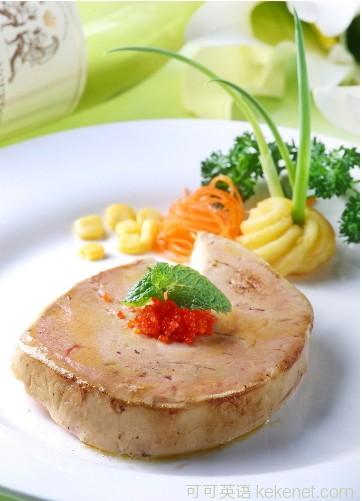
Science and Technolgy
科技
Foie-gras production
論鵝肝
How much is too much?
多少是個度
Why some duck livers are delicious, and others nasty
為什么有的鵝肝是珍饈,有的卻讓人惡心
FOIE GRAS is one of the most controversial dishes on earth. To protagonists, it is simply the finest foodstuff that exists. To those opposed, it is a product of cruelty that is not far short of criminal. The overfeeding of ducks and geese, so that their livers bloat to between six and ten times their normal size and take on a buttery consistency valued by gourmets, exploits the ability of these birds to store large amounts of calorie-rich fat, which was needed to propel them on the long migrations that their wild ancestors would routinely have undertaken. The moral argument over the way foie gras is produced (by feeding the birds with grain, through a tube or a funnel) turns on whether this is merely the permissible exaggeration of a natural inclination, or is tantamount to abuse. Intriguingly, a newly published piece of research on foie-gras production suggests the quality of the product depends on exactly the same distinction.
鵝肝是這世上最富爭議的食物之一。支持鵝肝的人說它是最美的珍饈;而反對者則認為制作鵝肝與犯罪無異。鴨鵝被過度灌食后,肝臟將變?yōu)檎K降?至10倍并呈現(xiàn)出美食家所推崇的黃油狀,肝臟貯存脂肪的能力被充分挖掘。鴨鵝的祖先需要定期長途遷徙,而這些脂肪可以為其提供充足的能量。制作鵝肝*(用管子或漏斗對鴨鵝灌飼谷物)涉及一個道德問題:這種做法究竟是在可接受的范圍內(nèi)將動物自身的功能發(fā)揮至極致,還是一種虐待行為。有意思的是,最近發(fā)表的一篇關于制作鵝肝的研究認為,鵝肝的質量取決于這一問題。
From the chef's point of view, one of the disturbing things about foie gras is how variable it is. Some livers, when cooked, retain their fat and thus their rich flavour. Others lose fat when heated and end up tasting terrible. To try to work out why, Caroline Molette, a biologist at the University of Toulouse, did some experiments. Her results, just published in the Journal of Agricultural and Food Chemistry, suggest that the difference is whether the liver in question is truly healthy or not.
在廚師看來,鵝肝的麻煩事之一是質量參差不齊。有些肝臟烹飪后還保留著脂肪、油膩感十足。有些肝臟在加熱后脂肪就沒了,相當難吃。為了搞清楚其中緣由,法國圖盧茲大學(University of Toulouse)的生物學家Caroline Molette進行了實驗,并將結果發(fā)表于《農(nóng)業(yè)與食品化學雜志》(Journal of Agricultural and Food Chemistry)。她認為其中差別在于所用肝臟健康與否。
Dr Molette and her colleagues raised 150 male mule ducks (a cross between Pekin and Muscovy ducks that is often used to produce foie gras) for 13 weeks in standard poultry-house conditions and then transferred them into individual enclosures. For a further 12 days the birds were fattened up with a mash of grain and flour—the usual procedure for enlarging their livers. They were then slaughtered, their livers removed, and those livers immediately trimmed of their blood vessels and chilled for six hours.
Molette博士與其同事將150只雄性雜交鴨(北京鴨與疣鼻棲鴨的雜交種,常用于生產(chǎn)鵝肝)在家禽飼養(yǎng)場標準條件下養(yǎng)殖13周,然后轉入單獨的籠子中。在之后的12天,用谷物和面粉的混合物灌飼鴨子——這是讓肝臟變大的常用步驟。然后處死鴨子,取肝臟,快速剔除血管,冷藏六小時。
So far, so normal. But instead of cooking the whole things, Dr Molette removed a 200-gram sample from each liver (an average liver weighed 550 grams) and put the rest in cold storage. She then placed each sample into a jar with a bit of salt and pepper, and cooked it for an hour. As she expected, some livers released a lot of fat when cooked while others released little. Armed with this information, she was able to turn her attention back to the uncooked sections of the livers and see if she could find any systematic chemical differences between them.
到此階段,一切正常。然而Molette 博士并沒有使用整個肝臟,而是從每份肝臟(均重550克)中取200克作為樣品,其余冷藏。她將每個樣品分別放置在罐子中,加入少許鹽和胡椒,烹飪半小時。正如她所料,烹飪時有些肝臟釋放出大量脂肪,而有些卻不是。獲得這一信息后,她就將目光轉向至還沒處理的那部分肝臟,她想知道這二者之間是否存在系統(tǒng)性化學差異。
Using a combination of electrophoresis (which sorts proteins according to their size and electrical properties) and mass spectrometry (which sorts fragments of those proteins according to their weight), she was able to do just that. The upshot was that the fat-retaining livers were rich in a variety of proteins known to help the body digest and store food. In the fat-shedding livers, by contrast, she found high concentrations of a protein called fatty-acid-binding-protein 4. In a human liver, this would be a marker of disease. Put simply, the fat-retaining livers are healthy while the fat-shedding ones are not.
Molette 博士使用電泳(根據(jù)蛋白質的分子大小和電荷差異,將蛋白質分離)和質譜(根據(jù)分子量將蛋白碎片分離)測定來進行實驗。結果發(fā)現(xiàn),保留脂肪的蛋白質富含多種有助于人體消化和貯存食物的蛋白質。相比之下,她在沒有脂肪的肝臟中發(fā)現(xiàn)了一種名為脂肪酸-結合蛋白4的蛋白質,且濃度很高。在人類肝臟中,這種蛋白是一種疾病指示物。簡單的說,保留脂肪的肝臟是健康肝臟,而沒有脂肪的肝臟不健康。
Both sides of the debate, then, are right. Foie-gras production can be a form of abuse but is not necessarily so, for an enlarged liver can still be healthy. The question is, how do you draw the line?
所以,討論雙方說的都對。生產(chǎn)鵝肝可以是一種虐待行為,但也可以不是,因為超大肝臟仍然可以是健康的。問題在于,分界線在哪里?
Dr Molette's ducks were all treated similarly, and their livers were of more or less the same size (certainly, the fat-shedding ones were not systematically heavier). The search is therefore on for some way to tell in advance which animals will respond positively to extra helpings and which will not. That knowledge would help farmers, gourmets and animal-lovers alike.
Molette博士的鴨子,處理方法相似,肝臟大小差不多一樣(當然,沒有脂肪的肝臟總體來說不會更重)。所以,這項研究可以從某種角度提前告訴我們:哪些動物對過度喂食反應良好,哪些不是。這一點也可幫助農(nóng)民、美食家、以及動物愛好者。











